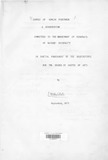Supply of Kenyan Pyrethrum
| dc.contributor.author | Odada, JEO | |
| dc.date.accessioned | 2013-05-28T15:31:24Z | |
| dc.date.available | 2013-05-28T15:31:24Z | |
| dc.date.issued | 1975-09 | |
| dc.identifier.citation | Master of Arts, University of Nairobi 1975 | en |
| dc.identifier.uri | http://erepository.uonbi.ac.ke:8080/xmlui/handle/123456789/26688 | |
| dc.description.abstract | Kenya's pyrethrum industry provides self employment to over eighty thousand rural families. Over two thousand people find wageemployment in the Pyrethrum Marketing Board's factory. Others earn regular incomes from collection and transportation networks. Pyrethrum is Kenya's fourth most important export crop, accounting for about SlX per cent of .Kenya's total foreign exchange earnlngs each year. Knowledge of farmers" responsiveness to changes in economic variables is iQportant in formulating agricultural policies. This study attempts to estimate Kenyan pyrethrum farmers' responsiveness to price changes. Time series data on output, acreage and price are used to estimate aggregate and regional supply flllctions. Nerlove's Partial Adjustment model fits the Kenyan pyrethrum data better than the Fisher distributed lag model. Fmpirical results suggest that Kenyan pyrethnm farmers are highly responsive to price cbanges and that the price-elasticity of pyrethrum supply varies from one region to another. Some policy implications are drawn from these results. | |
| dc.language.iso | en | en |
| dc.publisher | University of Nairobi. | en |
| dc.title | Supply of Kenyan Pyrethrum | en |
| dc.type | Thesis | en |
| local.publisher | Faculty of Arts | en |

